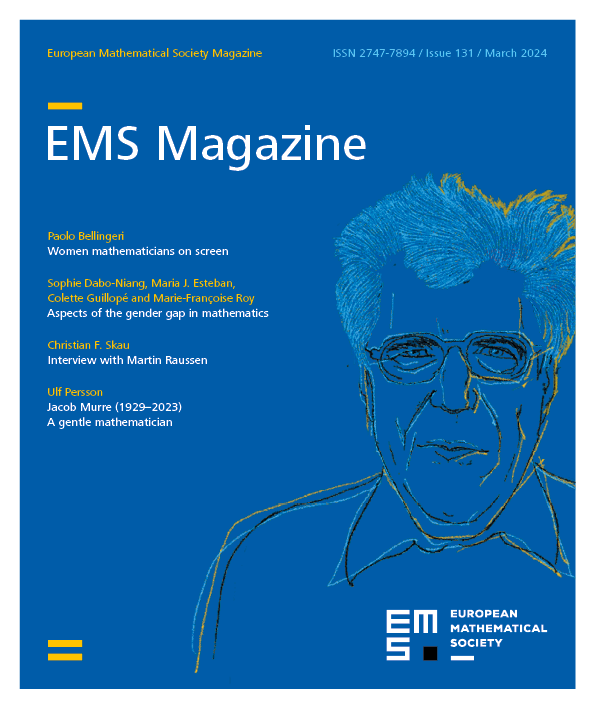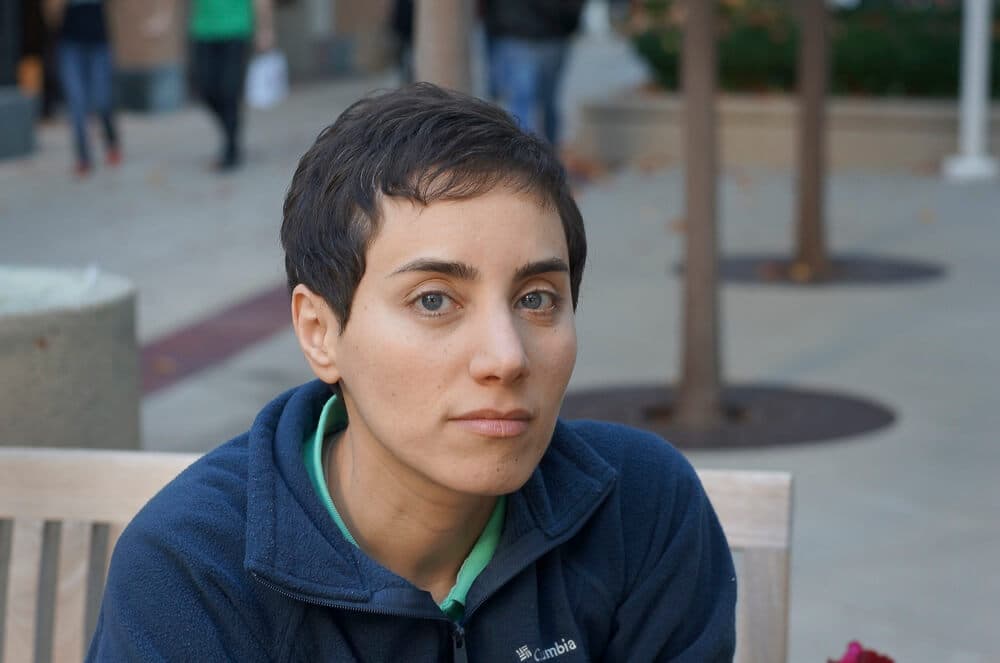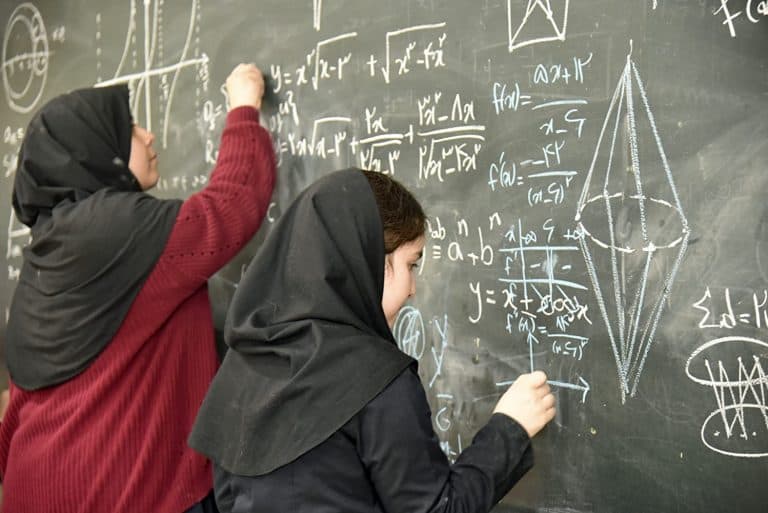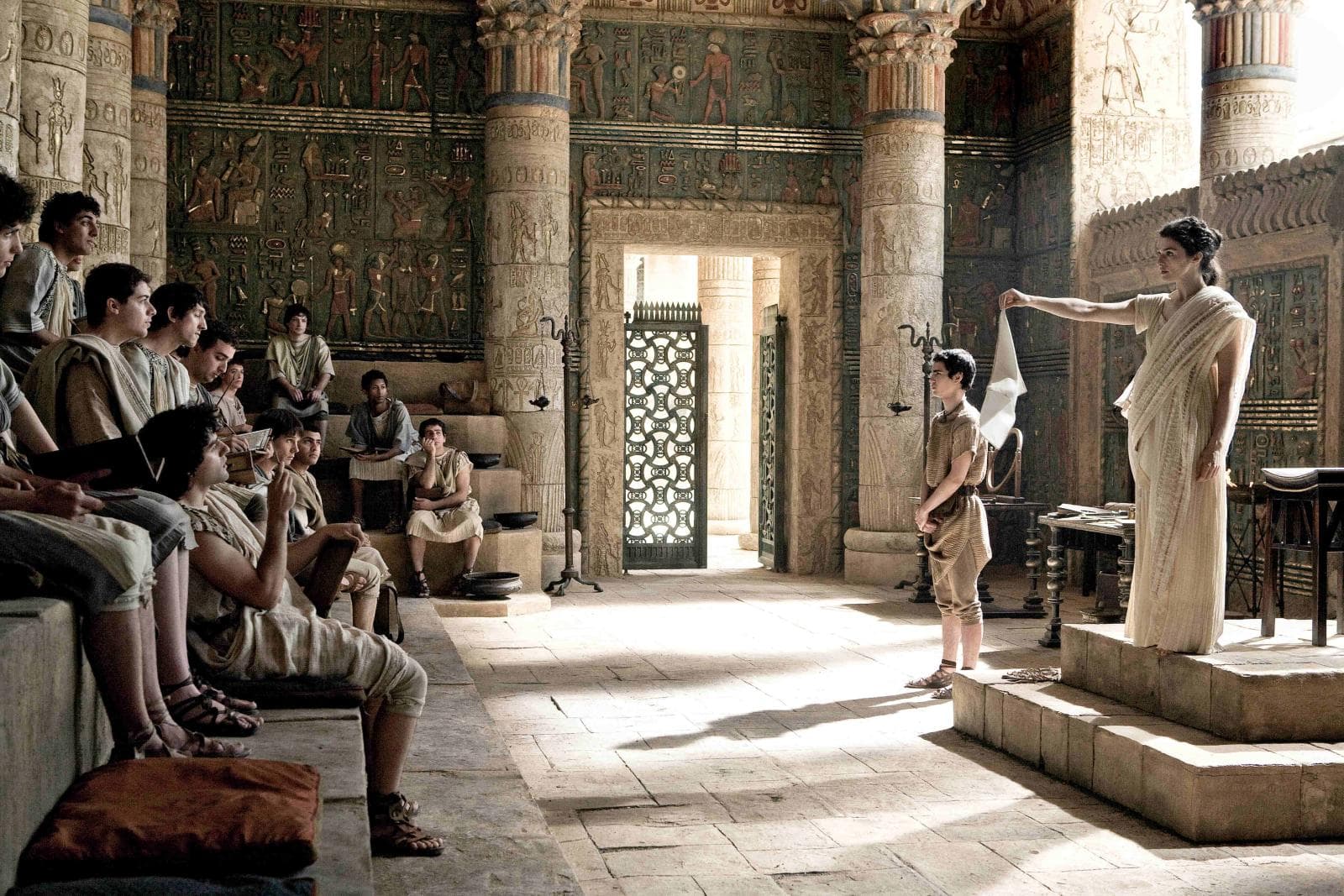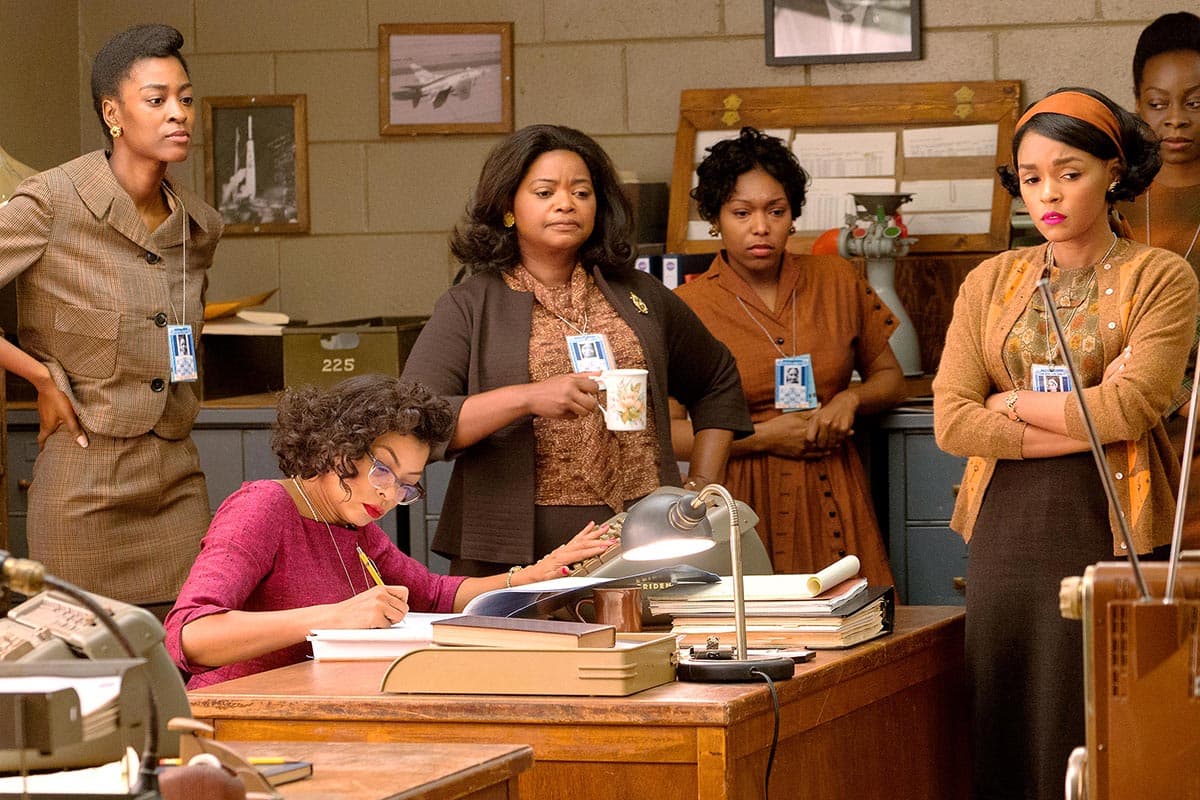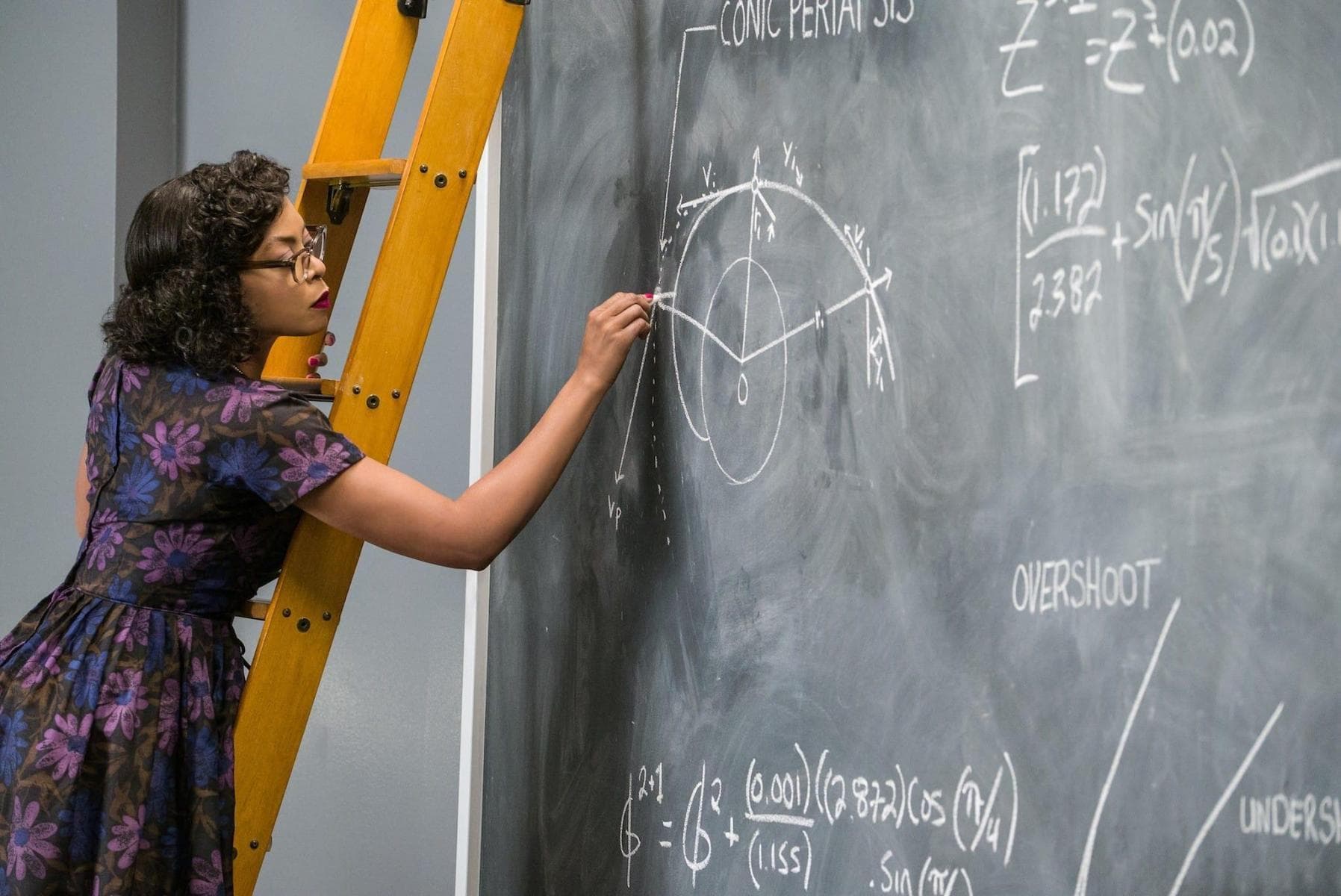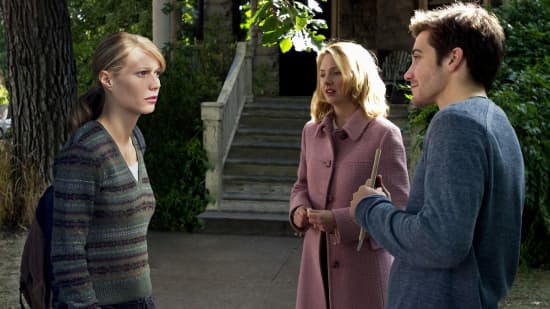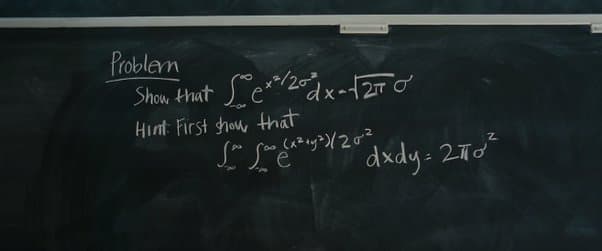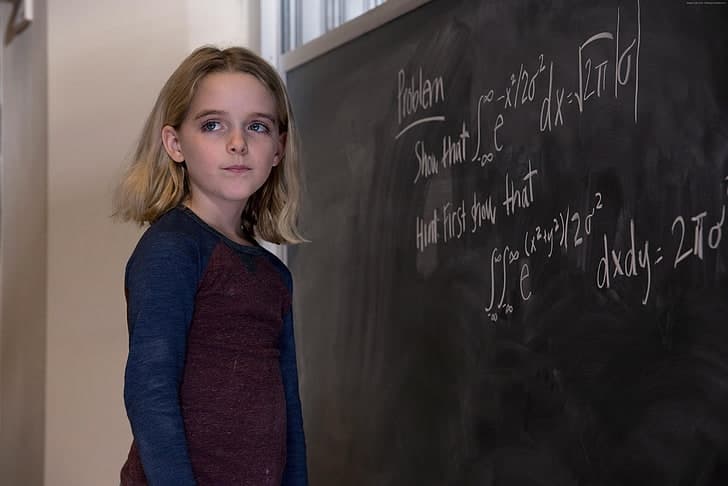While remaining a very rare phenomenon, female mathematicians do appear in movies, often as protagonists, revealing the director’s real commitment to character building. The aim of this article is to explore the representation of female mathematicians on screen, both fictional and real, of all ages and from different eras, to spot cliché, observe shifts in perspective and identify specific aspects that make the female role particularly important, not only from a narrative point of view, but also as for the intended message of the movie.
In 2020, during the Pariscience International Science Film Festival, the documentary Secrets of the Surface: The Mathematical Vision of Maryam Mirzakhani, directed by George Paul Csicsery with the support of Berkeley’s Mathematical Science Research Institute, was shown on the festival’s TV platform. The health crisis has particularly hampered the distribution of this documentary, which, without much fanfare, makes its way from festival to festival alongside mathematical conferences, but is now finally starting to become better known, thanks in particular to various initiatives to promote the sciences among young girls.
All rights reserved. Zala Films
The movie is a tribute to the mathematical work and the person of Maryam Mirzakhani (Figure 1): we follow her at Teheran Girls’ High School, at the International Mathematical Olympiad (with her two gold medals), during her studies at Sharif University of Technology and Harvard, and later at Stanford, at the time of her Fields Medal in 2014, before concluding with images of and interviews with young pupils and university students in Iran who show the impact and influence of her persona in the dissemination of mathematics in her native country.
The movie offers several levels of interpretation: we “see” mathematics and mathematical places, and we listen to mathematicians describing the importance and fruitfulness of Maryam Mirzakhani’s work. We also learn about personal, sometimes dramatic moments in her life, and feel the emotions of those who were close to her. These different paths allow us to sketch a portrait of Maryam Mirzakhani as a whole, and effectively show how the mathematical and human planes are intertwined, rejecting the usual cliché of the cold, asocial mathematician isolated in his or her own world.
At the same time, the movie introduces us to the Iranian education system (Figure 2), which was one of the director’s stated aims and could represent an interesting starting point for a future discussion on the topic of “girls in scientific disciplines.”
All rights reserved. Zala Films
George Paul Csicsery has dedicated much of his career to documentaries about the mathematical community. Probably the best-known of his documentaries is the first, N is a Number: A Portrait of Paul Erdős (1993), which depicts the life and mathematics of Paul Erdős. The figure of Erdős fascinated Csicsery, who subsequently decided to continue his journey among contemporary mathematicians.
Let us mention Julia Robinson and Hilbert’s Tenth Problem (2008) at this point, because there are several motifs in this film that were later taken up in Secrets of the Surface: the difficulties inherent in being a woman in a man’s world, the parallel description of the individual and their mathematics, but above all the vision of Mathematics overcoming borders and differences. The documentary also looks at Julia Robinson’s scientific cooperation with Yuri Matiyasevich, at the height of the Cold War. Through these multiple aspects, the film reflects Julia Robinson’s vision of mathematicians as citizens of a nation, irrespective of place, gender, religion or even time [1 S. Beccastrini and M. Nannicini, Il Cinema e la Matematica: Sulle tracce di una promettente amicizia. Erickson, Trento, Italy (2010) , 4 M. Du Sautoy, La symphonie des nombres premiers. Points, Paris, France (2003) ].
Csicsery’s work is particularly noteworthy given the scarcity of documentaries on female mathematicians; indeed, we need to broaden the spectrum of media and look further afield, to the past and to other cinematographic genres. We might mention, for example, the comics doc Je suis Sophie Germain, femme et mathématicienne (2021), produced to coincide with the release of the comic strip Les Audaces de Sophie Germain [5 E. Tartaglini, A. Filippini and A. Ferrari, Les audaces de Sophie Germain. Petit à Petit, Rouen, France (2021) ], or Girls who fell in love with Math (2017), a Taiwanese documentary about mathematicians Alice Zhang and Fan Chung Graham. Even in Olivier Peyon’s documentary Comment j’ai détesté les mathématiques (2013), there are hardly any female mathematicians: the only woman to appear in a proper role in this story is a psychologist who treats math phobia in children….
1 Mathematicians and heroines, from Agora to Hidden Figures
Leaving the world of documentaries behind, movies about “real” female mathematicians remain isolated and hard to find. Take, for example, Sofya Kovalevskaya, whose life lends itself particularly well to cinematic transposition, as was the case recently for John Nash (A Beautiful Mind by Ron Howard, 2011), Srinivasa Ramanujan (The Man Who Knew Infinity by Matt Brown, 2015) or Alain Turing (The Imitation Game by Morten Tyldum, 2014). In [1 S. Beccastrini and M. Nannicini, Il Cinema e la Matematica: Sulle tracce di una promettente amicizia. Erickson, Trento, Italy (2010) ], which is a remarkable work on mathematics and cinema, the authors cite three movies about the Russian mathematician: of the first, made in the USSR in 1956 and entitled Sofya Kovalevskaya, the authors were just able to discover the existence and director (Iosif Shapiro)1The author is thankful to the language editor for finding a copy of the movie: https://www.youtube.com/watch?v=kMMCFa8qEUA, and of another TV film about Sofya Kovalevskaya: https://www.youtube.com/watch?v=zVRV-o0z5pg. while the other two are a Swedish movie from 1983 (A Hill on the Dark Side of the Moon by Lennart Hjulström) and a Soviet mini-series from 1985 (Sofya Kovalevskaya2This mini-series, which saw the debut of actress Yelena Safonova, has the particularity of being a movie about a “real” mathematician that was directed by a woman, Ayan Shakhmaliyeva.). These works, however, are somewhat distant to us, in time as well as in terms of availability.
There are two movies which stand out as exceptions from this statement, and we can wonder whether they represent a change of perspective and the start of a new trend: Agora (2009) and Hidden Figures (2016). The mathematics of these two movies are detailed in [3 J. Cottanceau, Les maths font leur cinéma : De Will Hunting à Imitation Game. Dunod, Malakoff, France (2021) ], while here we will focus on the representation of female mathematicians and their activity.
All rights reserved. Focus Features/Fox International
Agora (Figure 3) is, cinematically speaking, a peplum, which is original in its theme and approach. The action is set in Egypt between 390 and 415: the protagonist is Hypatia of Alexandria, played by Rachel Weisz, a neoplatonic philosopher and the first female mathematician we know of. While we have some information on her research (in particular, she had studied Ptolemy’s astronomical texts, which justifies the movie’s discussions of the Earth’s position in relation to the Sun) and her tragic end (she was murdered), there is no written record of her work. This allowed the director (Alejandro Amenábar) a great deal of freedom in constructing the character, in particular, from a mathematical point of view: the movie talks about mathematics known at the time (Euclid and the Apollonius cone are cited, among others) but, as noted in [3 J. Cottanceau, Les maths font leur cinéma : De Will Hunting à Imitation Game. Dunod, Malakoff, France (2021) ], it remains highly improbable that Hypatia could have discovered the Earth’s elliptical trajectory, and even less so through the approach proposed in the movie, based essentially on the gardener’s method of tracing an ellipse.
In terms of historical facts, there were quite a few liberties taken, too: Hypatia’s assassination was made to coincide with the destruction of the Temple of Serapis (where the remains of the Library were kept), and was attributed to the Christians. Without entering into discussions of a historical or epistemological nature, this set of narrative choices, which incidentally contrast with the meticulous and aesthetically pleasing reconstruction of Alexandria, transforms the character of Hypatia into pure fiction, reducing her to the message the movie wishes to convey: that of science confronting obscurantism and fanaticism. Nonetheless, the movie remains a singular and interesting tribute to an important figure in history (not just in mathematics) who had hitherto been ignored by the world of cinema.
All rights reserved. 20th Century Fox
Hidden Figures is a biographical movie directed by Theodore Melfi. It is based on Margot Lee Shetterly’s book about three African American female mathematicians who worked at NASA during the space race: Mary Jackson (Janelle Monáe), Katherine Johnson (Taraji P. Henson) and Dorothy Vaughan (Octavia Spencer) (the three actresses in the foreground in Figure 4). The movie also stars Kevin Costner, Kirsten Dunst and Jim Parsons (again playing the role of a physicist, as in The Big Bang Theory TV series), among others. Despite its initially rather modest release, Hidden Figures proved to be one of the most profitable movies of 2016, grossing 236 million USD worldwide and receiving rave reviews from critics, along with three Oscar nominations, including for Best Picture.3While A Beautiful Mind is so far the only movie about mathematics to have won an Oscar, two other “mathematical” movies had received a nomination before Hidden Figures: The Imitation Game and Bennet Miller’s Moneyball, 2011.
Mary Jackson, Katherine Johnson and Dorothy Vaughan were among the “computer women” at NASA whose commitment contributed to the success of the first space missions, but who were subsequently overlooked by history. As is often the case, the movie compromises with reality (it is not a documentary): for example, the action is concentrated on the years 1961 and 1962, whereas the three women did not work at NASA in that period, and the chronology of most of the facts cited is not respected. More important, however, is the fact that the movie remains essentially “true.” Dorothy Vaughan was the first African American woman to be appointed team supervisor at NASA (in programming) and one of the pioneers of FORTRAN programming. In parallel, Mary Jackson is highlighted for her fight to abolish anti-segregation laws in the United States (she was allowed to take courses reserved for whites) and for her career path that led her to become the first black woman engineer at NASA. The leading role in the movie is given to Katherine Johnson and her work as a mathematician on the trajectory calculations for John Glen’s Mercury mission in 1962. As far as mathematics are concerned, it is first of all worth noting that they are omnipresent in the movie, serving as backdrops: there are some forty blackboards (Figure 5) where formulas ranging from quadratic equations to trajectory calculations are sketched out. There are also a few shortcuts or even mistakes, for example in the scene in which Katherine Johnson demonstrates her mathematical skills by finding a good approximation to the landing coordinates (in which the actress seems to confuse the initial data with the result [3 J. Cottanceau, Les maths font leur cinéma : De Will Hunting à Imitation Game. Dunod, Malakoff, France (2021) ]), or in the presentation of Euler’s method as a solution for calculating the instant of passage to change John Glen’s capsule from an elliptical to a parabolic trajectory (it was rather variants, such as those of Runge–Kutta, which are far more reliable, that were actually used). However, this does not detract from the message. We see three women asserting themselves in three different fields: applied mathematics, space engineering and computer science. And even if the story remains a fairly classic one of the American dream, we appreciate the depiction of mathematics as being a key to development, thanks to both personal and collective skills, as in the scene where the “colored computers” are transferred to the IBM computer section. Mathematics can thus help overcome discrimination, in the spirit of Julia Robinson and her idea of mathematicians as a common nation, as the three women, in three different scenes, are finally accepted as colleagues and scientists.
All rights reserved. 20th Century Fox
In this sense, the movie is also reminiscent of The Man Who Knew Infinity when describing the relationship between Hardy and Ramanujan (at first essentially mathematical and complicated by cultural differences) and then Hardy’s struggle to have Ramanujan’s work recognized. Similar themes are dealt with in the mini-series The Bletchley Circle, which follows four women (played by Julie Graham, Anna Maxwell Martin, Sophie Rundle and Rachael Stirling) who worked at Bletchley Park, a British code-breaking site during the Second World War, which is also the setting for The Imitation Game. After the end of the war, having sworn not to reveal their wartime activities and being forced to return to the not-so-stimulating daily lives of housewives or secretaries, they set out to solve criminal investigations using their logic and reasoning skills. Without pretending to do historical studies, it is interesting to observe how, in both cases, women were able to enter a man’s world – the world of war or the conquest of space – thanks to their skills, but also to the high demand of such skills, being later (once these exceptional circumstances had disappeared) totally disregarded for reasons of state secrecy and, above all, obvious discrimination.
2 Women mathematicians in fiction: clichés and singularities
After talking about “real” women mathematicians in documentaries and movies, let us move on to the “fictional” women mathematicians. A puzzling remark at first sight concerns the percentage of female mathematicians on screen, which seems higher than in real life. In fact, in movies dealing with mathematics, women mathematicians are very much in evidence. Of course, this observation needs to be put into perspective, given the (under)representation of mathematics in cinema. The Mathematical Fiction site cites around 160 movies that deal (at least vaguely) with mathematics, while Mathematics in Movies lists around 170 excerpts of mathematics in movies4It should be remembered, too, that there are several excerpts from the same movie, and that some excerpts are very short, even insignificant.: they are negligible numbers in relation to the worldwide film production. What is more, we note that on the rare occasions when mathematics is mentioned in cinema, it is to complain about it. In Hollywood hates maths Dan Mayer reminds us that mathematics often appears on screen in the form of little negative phrases, which represent a “fictional” mirror of the difficult relationship audiences can have with mathematics. While mathematics is often “mistreated” in movies and sometimes reduced to comic effects, female mathematicians are portrayed with recurring clichés that are, incidentally, the same as those found for their male colleagues. They are cold (granddaughter Therèse in Antonia’s Line by Marleen Gorris, 1995), shy or awkward (the protagonist of She Wrote the Book by Charles Lamont, 1946), sometimes troubled by alcoholism or other addictions (Béatrice Dalle, alcoholic logician in Domaine by Patric Chiha, 2008) or even suicidal. In the mini-series The Queen’s Gambit, the protagonist’s mother (played by Chloe Pirrie) is a mathematician (at one point she burns her doctoral thesis in Mathematics: Monomial Representations and Symmetric Presentations) who suffers from severe mental problems that drive her to deliberately kill herself in a car, while also trying to get rid of her own daughter (perceived by the mother as “a problem to be solved”).
All rights reserved. JTBC
Sometimes women mathematicians are also murderers.5This is the case with male mathematicians, too, who may even be multi-murderers (Straw Dogs by Sam Peckinpah, 1976), serial killers (Bianca by Nanni Moretti, 1983) or contract killers (The Accountant by Gavin O’Connor, 2016). In Alan Pakula’s Presumed Innocent (1990), Bonnie Bedelia plays a mathematician who fails to complete her studies and kills the lover and colleague of her husband (Harrison Ford). In the Korean series Sky Castle (2018, Figure 6) Kim Seo-hyung plays an entrance exam preparer at Seoul National University (SNU), South Korea’s most prestigious university. Since all her students succeed in getting into SNU, she is highly sought-after by Seoul’s wealthy families. In reality, she is a high-level mathematician who has emigrated to the USA and is hiding a dark secret. In conflict with her husband over the education of their gifted daughter, she causes a car accident in which her daughter is also involved, leaving her handicapped for life. Back in Korea, in search of revenge, she tries to destroy the families who entrust her with their children, and ends up committing another murder after that of her husband in the USA. Sky Castle, which is a fierce critique of the Korean education system and a major box-office hit in Asia, shows the importance of mastering mathematics in the ruthless selection of Korean students, and features numerous teaching scenes (in class, in private lessons, between students).
In both Presumed Innocent and Sky Castle, the validity of the murderous plan is “certified” by the fact that the killer is a mathematician, and therefore “by definition” intelligent and not very empathetic. However, the motivations behind the murders and the work on the character are very different: In Presumed Innocent, the fact that the murderer is a mathematician is of marginal importance, adding professional frustration (the unfinished thesis) to the personal frustration (the husband’s betrayal) of the gap between reality and the desire for a world governed by clear, unchanging rules. By contrast, the woman mathematician in Sky Castle is a far more complex character: there is the social affirmation through mathematics, the difficulty of relating to others (to one’s own child), the retribution and revenge against a society that sees preparators (and mathematics) as essential means, but which can be discarded once admission to a major university has been achieved.
Presumed Innocent is not the only example. Mathematical characters are rarely explored in depth in cinema. Most of the time, we discover a woman mathematician by watching her write mathematics on a blackboard: scenes that create context, justified by the plot, but which remain narratively secondary. That said, these scenes can be of high quality, even from a mathematical point of view: in Claudia Weill’s It’s My Turn (1980), the protagonist is a university professor (played by Jill Clayburgh), and in one scene she demonstrates the Snake Lemma to students. It is also curious to note the analogies with Marleen Gorris’ Antonia’s Line: two movies by two female directors in which mathematicians discuss homological algebra on a blackboard. The proof is correct and this scene is quoted in An Introduction to Homological Algebra by Charles Weibel [6 C. A. Weibel, An introduction to homological algebra. Cambridge Stud. Adv. Math. 38, Cambridge University Press, Cambridge, UK (1994) ], who writes:
We will not print the proof in these notes, because it is best done visually. In fact, a clear proof is given by Jill Clayburgh at the beginning of the movie It’s My Turn.
However, as in the case of movies about real-life female mathematicians, we have seen a growing focus on the character construction over the years. Examples include two relatively recent movies, Proof (2005) and Gifted (2017), which break away from certain stereotypes and tackle new subjects.
Proof, directed by John Madden (Figure 7), is a cinematic adaptation of David Auburn’s 2001 Pulitzer Prize-winning play of the same name. The narrative alternates between events following the death of a brilliant mathematician (Anthony Hopkins) from dementia, and flashbacks to the life he shared with his daughter Catherine (Gwyneth Paltrow). Being also a mathematician, she interrupted her studies to take care of her father and also because of personal problems (she struggles with the imposing father figure, whose mental illness she fears she has inherited).
All rights reserved. Miramax Films
The proof referred to in the movie seems to be that of the Riemann hypothesis; even though this choice may appear incongruous, it is functional to the narrative, as it would seem natural for us too to doubt any possible proof! The movie follows Catherine’s painful journey, her fear of sinking into madness, the difficulty of asserting herself as a mathematician, but above all it tackles the problem of the paternity (maternity, in this case) of a proof. Catherine makes Hal (Jake Gyllenhaal), the father’s former student, find a notebook with an important proof, claiming that it was she who wrote it, not her father. Neither Hal nor Catherine’s sister Claire (Hope Davis) believe her. Hal and Claire embody Catherine’s fears, that is that she could not live up to her father’s standards (Hal thinks the mathematics used in the notebook are beyond Catherine’s grasp) and that she is also mentally ill (her sister Claire’s suspicion). It is only towards the end of the movie that Hal, after discussions with colleagues, says he believes her (the mathematics used are new) and wants to discuss the proof with her. Shortly afterwards, Catherine faces her fears, deciding to stay and not leave with her sister. In this sense, the movie, without really showing mathematics, proposes a scientific path that may seem plausible, describing the difficulties that can arise for a woman mathematician in a man’s world (the only other mathematicians who appear in the movie, living or dead, are men). A discussion of Catherine’s career also touches on the underrepresentation of women in mathematics. The heroine mentions Sophie Germain as an example of a great female mathematician.
Marc Webb’s Gifted (French title: Mary) tackles the subject of gifted children. The protagonist is Mary (Mckenna Grace), a seven-year-old girl with an uncommon aptitude for mathematics, who is the subject of a violent difference of opinion between her uncle Frank (Chris Evans) and her grandmother Evelyn (Lindsay Duncan) concerning the way she should be raised. The former, who has been her guardian since the suicide of his sister, Mary’s mother and a brilliant mathematician, would like to ensure her a normal childhood (also in the light of his own experience), while her grandmother wants to take her back to Massachusetts and enroll her in a school for geniuses. The motif of the mathematically gifted child is not new: it can also be found in Dear Brigitte (by Henry Koster, 1965), Little Man Tate (by Jody Foster, 1991) and Antonia’s Line. The originality of Gifted lies in the attention it pays to mathematics and its contextualization in the narrative. Director Marc Webb, the son of an educational mathematician, has surrounded himself with four mathematical consultants. The mathematical theme may come as a surprise, as it is nothing less than Navier–Stokes: moreover, at the end of the movie we discover that this millennium problem (yet another one6Another millennium prize problem solved in cinema is “PNP,” in an episode of the series Elementary, to be precise. In fact, it is stated that the mathematician found dead had demonstrated “a third of it,” which, as Jean-Paul Delahaye remarked, is a rather astonishing statement for us. Note also that the murderer is, once again, a mathematician.) was demonstrated by Mary’s mother, who wanted it to remain a secret until her mother Evelyn’s death.
Like Proof, Gifted also shows the impact of the Millennium Prize Problems on the collective imagination, but unlike Proof, Gifted immerses us in mathematics. These are surprisingly correct for fiction, although their spectrum is very scattered (we encounter Trachtenberg, congruences and integrals). Particularly striking is the scene in which a teacher challenges Mary to prove the equation in Figure 8:
All rights reserved. Fox Searchlight Pictures
Mary does not answer because she has been advised not to correct grown-ups, but she eventually comes back and corrects the equation on the blackboard by adding a “” sign in front of and putting as an absolute value (Figure 9).
All rights reserved. Fox Searchlight Pictures
The absolute value is actually unnecessary, as the standard deviation is a positive number. As Cottanceau remarks, “this little detail shows that Mary has great intuition … but not yet enough experience to contextualize the problems presented to her.” The demonstration finally seems correct, and this scene is coherent “in the parallel universe where a first-grade girl shows such abilities” [3 J. Cottanceau, Les maths font leur cinéma : De Will Hunting à Imitation Game. Dunod, Malakoff, France (2021) ].
3 Conclusion
Over the last few years, it seems that cinema’s view of mathematics has evolved towards a more complex and sophisticated approach, and therefore a more realistic and convincing one. While we cannot ask cinema to explain mathematics (that is not its role), we can applaud the fact that recent works show us that it is possible to be passionate about mathematics, and how they can be interesting and convey positive messages. Even if certain stereotypes appear to persist, male and female mathematicians are increasingly emerging as characters in their own right who deserve to be developed cinematically. Female mathematicians, whether real or fictional, are particularly interesting because they enable directors and screenwriters to tackle a number of other themes in parallel: the conflicting relationship between what is rational and what is emotional (traditionally embodied by female sensibility in cinema), discrimination, the difficulty of emerging scientifically in a world of men. On the other hand, we see the strength of belonging to a community, primarily of women, as in The Bletchley Circle or Hidden Figures, or more generally, as part of the mathematical “nation,” the one Julia Robinson spoke about.
In conclusion, the number of documentaries and movies about female mathematicians who actually existed is extremely limited, even within the cinematic niche of “mathematical” movies. As far as movies made by women are concerned, to the four we have mentioned above (Antonia’s Line, It’s My Turn, Sofya Kovalevskaya, Little Man Tate) we can add C’est la tangente que je préfère by Charlotte Silvera (1997), in which the protagonist is a young girl very gifted in logic. This is not an insignificant sample, and all these movies have met with some degree of public and/or critical success. That said, they are all concentrated on a short period of time, and, to my knowledge, no other female director has completed a mathematical movie (with international distribution) since 1997.7This was the case at the moment of the publication of the French version of the paper: in November 2023, the movie Le Théorème de Marguerite, about a female PhD student in mathematics, was released, directed by Anna Novion. This is actually a more general problem: just as an example, out of around 21,000 European feature films between 2003 and 2017 (European Audiovisual Observatory), only one in five was directed (or co-directed) by a woman. Yet another point that mathematics and cinema have in common: the road to equality is still a long one.
Acknowledgements. I would like to thank Marie Bocquillon, Marc Demeuse and Antoine Derobertmasure, editors of L’École à travers l’art et la (pop)culture, published by Mardaga, for allowing me to reproduce some of the ideas and texts from my contribution [2 P. Bellingeri, Langage universel, langage commun ? Comment le cinéma représente les mathématiques. In L’École à travers l’art et la (pop)culture, pp. 155–178, Mardaga, Bruxelles, Belgium (2022) ]. The EMS Magazine thanks La Gazette des Mathématiciens for authorisation to republish this text, which is an English translation of the paper entitled “Les mathématiciennes à l’écran” and published in La Gazette des Mathématiciens, Number 173, July 2022.
Sitography
Gender equality for film directors: Still a long way to go. Yearbook 2019/2020 European Audiovisual Observatory, https://rm.coe.int/yearbook-keytrends-2019-2020-en/16809ce58d
Mathematical Fiction. https://kasmana.people.cofc.edu/MATHFICT/all.php (2021)
O. Knill, Mathematics in movies. https://people.math.harvard.edu/~knill/mathmovies (2006)
D. Mayer, Hollywood hates maths. https://youtube.com/watch?v=NoaD-eIyC5g (2013)
A. Boyer, H. Pajot and F. Bastien, Je suis Sophie Germain, femme et mathématicienne. https://www.canal-u.tv/chaines/ifourier/je-suis-sophie-germain-femme-et-mathematicienne (2021)
J.-P. Delahaye, https://interstices.info/pnp-elementaire-ma-chere-watson (2014)
Filmography (by directors)
A. Amenábar, Agora. Fox International Production, Spain (2009)
M. Brown, The Man Who Knew Infinity. Pressman Film, UK (2015)
P. Chiha, Domaine. Aurora Films, Austria/France (2010)
G. Csicsery, N is a Number: A Portrait of Paul Erdős. USA (1993)
G. Csicsery, Julia Robinson and Hilbert’s Tenth Problem. USA (2008)
G. Csicsery, Secrets of the Surface: The Mathematical Vision of Maryam Mirzakhani. Zala Films, USA (2020)
J. Foster (woman), Little Man Tate. Orion Pictures Corporation, USA (1991)
L. Hjulström, Berget på månens baksida (A Hill on the Dark Side of the Moon). Moviemakers Sweden AB, Sweden (1983)
R. Howard, A Beautiful Mind. Universal Pictures, USA (2011)
M. Gorris (woman), Antonia’s Line. PolyGram Video, Belgium/Netherlands (1995)
Y.-J. Jiing and W. Wang, Girls Who Fell in Love with Math. Taiwan Film Institute, Taiwan (2017)
H. Koster, Dear Brigitte. 20th Century Fox, USA (1965)
C. Lamont, She Wrote the Book. Universal Pictures, USA (1946)
J. Madden, Proof. Miramax, USA (2005)
A. Makarenko, Sofya Kovalevskaya: The Dilemmas of a Great Woman. Bokun Studio, Russia (1997)
T. Melfi, Hidden Figures. Fox 2000 Pictures, USA (2016)
B. Miller, Moneyball. Columbia Pictures, USA (2011)
N. Moretti, Bianca. Faso Film / Rete Italia, Italy (1984)
A. Novion, Le Théorème de Marguerite. Pyramide Distribution, France (2023)
G. O’Connor, The Accountant. Warner Bros, USA (2016)
A. J. Pakula, Presumed Innocent. Warner Bros, USA (1990)
S. Peckinpah, Straw Dogs. 20th Century Fox, UK/USA (1971)
O. Peyon, Comment j’ai détesté les mathématiques. Haut et Court, France (2013)
M. Tyldum, The Imitation Game. Black Bear Pictures, USA (2014)
I. Shapiro, Sofya Kovalevskaya. Lenfilm, USSR (1956)
C. Silvera (woman), C’est la tangente que je préfère. Canal+ / CNC, France (1997)
M. Webb, Gifted. FilmNation Entertainment, USA (2017)
C. Weill (woman), It’s My Turn. Columbia Pictures, USA (1980)
Television series
The Bletchley Circle. 2 seasons. ITV, UK
Elementary. Season 2, episode 2. CBS Television Studios, USA
The Queen’s Gambit. Netflix, USA
Sky Castle. JTBC, South Korea
Sofya Kovalevskaya. Gosteleradio, USSR
- 1
The author is thankful to the language editor for finding a copy of the movie: https://www.youtube.com/watch?v=kMMCFa8qEUA, and of another TV film about Sofya Kovalevskaya: https://www.youtube.com/watch?v=zVRV-o0z5pg.
- 2
This mini-series, which saw the debut of actress Yelena Safonova, has the particularity of being a movie about a “real” mathematician that was directed by a woman, Ayan Shakhmaliyeva.
- 3
While A Beautiful Mind is so far the only movie about mathematics to have won an Oscar, two other “mathematical” movies had received a nomination before Hidden Figures: The Imitation Game and Bennet Miller’s Moneyball, 2011.
- 4
It should be remembered, too, that there are several excerpts from the same movie, and that some excerpts are very short, even insignificant.
- 5
This is the case with male mathematicians, too, who may even be multi-murderers (Straw Dogs by Sam Peckinpah, 1976), serial killers (Bianca by Nanni Moretti, 1983) or contract killers (The Accountant by Gavin O’Connor, 2016).
- 6
Another millennium prize problem solved in cinema is “PNP,” in an episode of the series Elementary, to be precise. In fact, it is stated that the mathematician found dead had demonstrated “a third of it,” which, as Jean-Paul Delahaye remarked, is a rather astonishing statement for us. Note also that the murderer is, once again, a mathematician.
- 7
This was the case at the moment of the publication of the French version of the paper: in November 2023, the movie Le Théorème de Marguerite, about a female PhD student in mathematics, was released, directed by Anna Novion.
References
- S. Beccastrini and M. Nannicini, Il Cinema e la Matematica: Sulle tracce di una promettente amicizia. Erickson, Trento, Italy (2010)
- P. Bellingeri, Langage universel, langage commun ? Comment le cinéma représente les mathématiques. In L’École à travers l’art et la (pop)culture, pp. 155–178, Mardaga, Bruxelles, Belgium (2022)
- J. Cottanceau, Les maths font leur cinéma : De Will Hunting à Imitation Game. Dunod, Malakoff, France (2021)
- M. Du Sautoy, La symphonie des nombres premiers. Points, Paris, France (2003)
- E. Tartaglini, A. Filippini and A. Ferrari, Les audaces de Sophie Germain. Petit à Petit, Rouen, France (2021)
- C. A. Weibel, An introduction to homological algebra. Cambridge Stud. Adv. Math. 38, Cambridge University Press, Cambridge, UK (1994)
Cite this article
Paolo Bellingeri, Women mathematicians on screen. Eur. Math. Soc. Mag. 131 (2024), pp. 4–10
DOI 10.4171/MAG/168